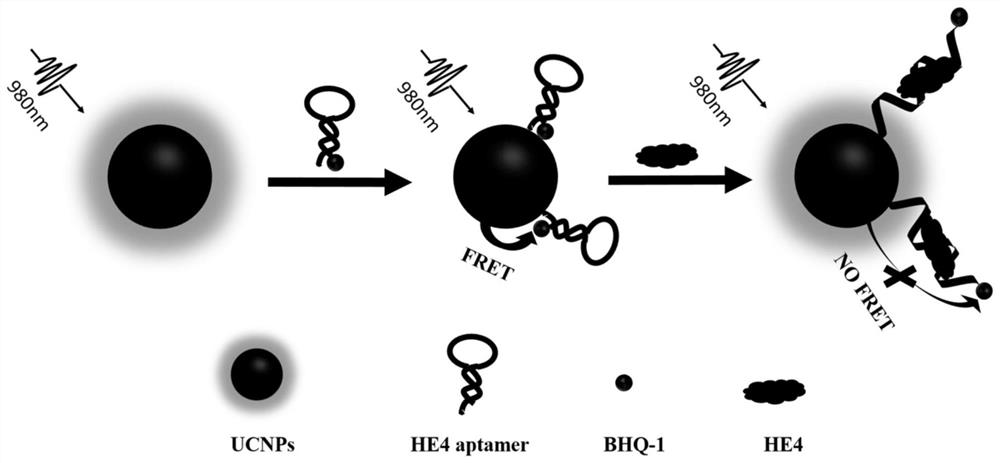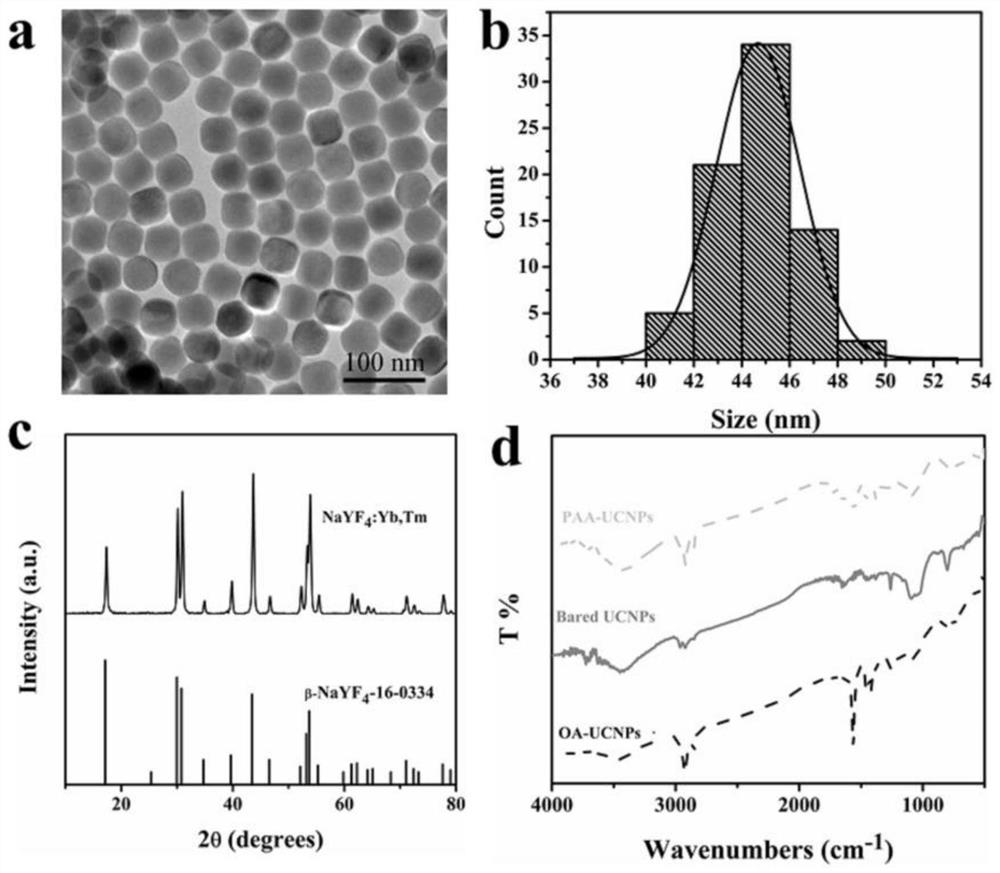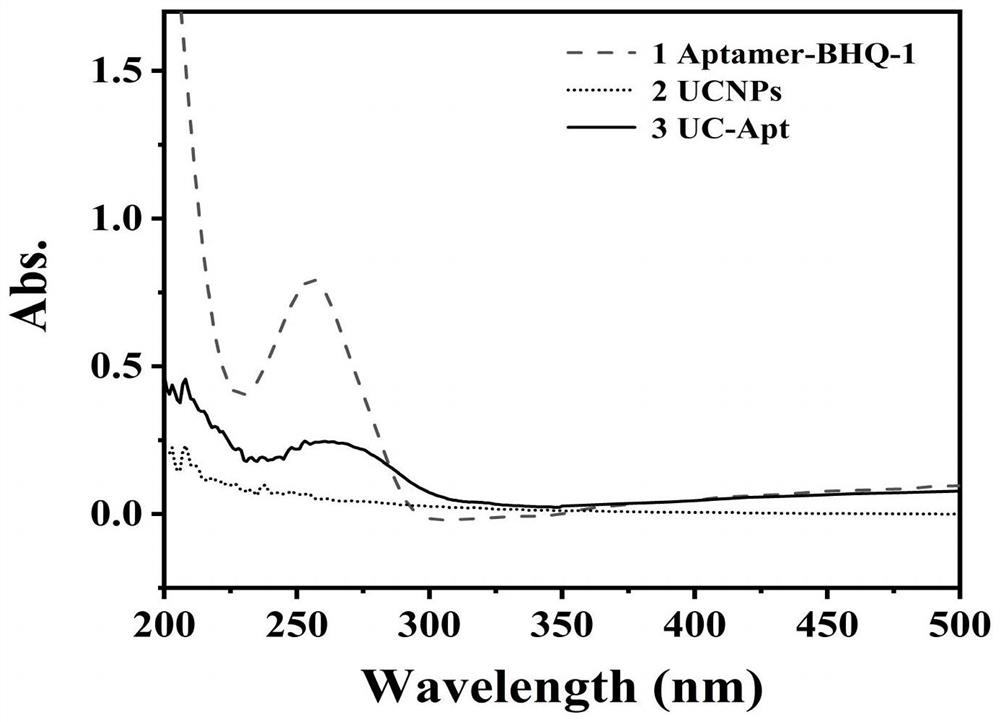Method for detecting human epididymis protein 4 based on resonance energy transfer of up-conversion nano material and BHQ-1
A resonance energy transfer, BHQ-1 technology, applied in the field of nanomaterials and analytical chemistry, can solve the problem of low detection sensitivity, achieve high sensitivity, improve accuracy and stability, and strong specificity.
- Summary
- Abstract
- Description
- Claims
- Application Information
AI Technical Summary
Problems solved by technology
Method used
Image
Examples
Embodiment 1
[0051] A method for preparing a water-soluble up-conversion fluorescent nanomaterial, comprising the steps of:
[0052] 1) Using rare earth chloride as a raw material, oleic acid as a ligand, and 1-octadecene as a solvent, high-temperature solvothermal method is used to synthesize rare earth up-conversion nanoparticles wrapped in oleic acid. The specific method is as follows:
[0053] a) Rare earth chloride raw material LnCl 3 Synthesized by air bath method:
[0054] 6mmol of Y with a molar ratio of 79.8:20:0.2 2 o 3 , Yb 2 o 3 and Er 2 o 3 The formed mixture was added into a one-necked bottle, 25mL of concentrated hydrochloric acid (36wt%-38wt%, the same below) was added thereto and heated until the solution was clear; then the temperature was raised and the solvent was evaporated to dryness and cooled to room temperature; then ultrapure water was added thereto simultaneously , absolute ethanol, and n-hexane, heated at 70°C for 5h, and after cooling to room temperature...
Embodiment 2
[0066] Preparation of upconversion fluorescent probes: Amidation reaction was used to modify the surface of the target cancer antigen HE4 aptamer on the surface of water-soluble upconversion fluorescent nanomaterials. The specific method is as follows:
[0067] Add 100 μL of 10 mg / mL water-soluble up-conversion fluorescent nanomaterial dispersion prepared in Example 1 (the up-conversion fluorescent nanoparticles wrapped with polyacrylic acid prepared in Example 1 are dispersed with ultrapure water) into 700 μL MES buffer solution ( 10mM, pH=5.5); then 100uL 5mg / mL EDC solution (1-ethyl-(3-dimethylaminopropyl)carbodiimide hydrochloride EDC·HCl was dissolved in MES buffer solution (10mM, pH=5.5)) and 100uL 10mg / mL N-hydroxysulfosuccinimide solution Sulfo-NHS (prepared in MES buffer solution (10mM, pH=5.5)) were added to the above solution, and then the mixture was heated at 35 Incubate at ℃ for 1 h to activate the carboxyl groups on the water-soluble up-conversion fluorescent na...
Embodiment 3
[0071] In order to investigate the effect of different fluorescent acceptor concentrations on the fluorescence quenching efficiency, this example, on the basis of Example 2, added different amounts of HE4 aptamer-BHQ-1 dispersions to the above prepared in Example 1. Convert the nanoparticles into the buffer solution and incubate at 37°C for 1 h to obtain the detection probe, then measure the upconversion fluorescence intensity of each mixture under a 980nm laser, and obtain the corresponding upconversion fluorescence intensity in the mixture solution with the largest fluorescence quenching efficiency. Convert fluorescent probe concentration and fluorescent acceptor concentration.
[0072] Figure 5 , 6 It is the result figure of the efficiency of the acceptor to the fluorescence quenching of the water-soluble up-conversion nanoparticles (the fluorescence intensity of the blank sample is F 0 , the fluorescence intensity of each group of mixed solutions after adding the HE4 ap...
PUM
 Login to View More
Login to View More Abstract
Description
Claims
Application Information
 Login to View More
Login to View More - R&D
- Intellectual Property
- Life Sciences
- Materials
- Tech Scout
- Unparalleled Data Quality
- Higher Quality Content
- 60% Fewer Hallucinations
Browse by: Latest US Patents, China's latest patents, Technical Efficacy Thesaurus, Application Domain, Technology Topic, Popular Technical Reports.
© 2025 PatSnap. All rights reserved.Legal|Privacy policy|Modern Slavery Act Transparency Statement|Sitemap|About US| Contact US: help@patsnap.com



